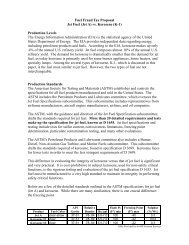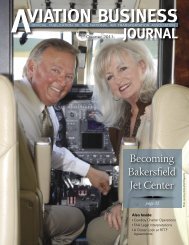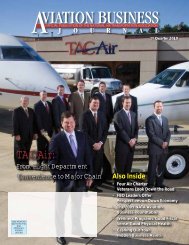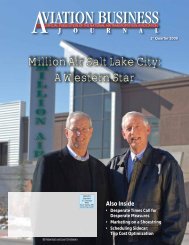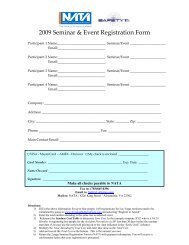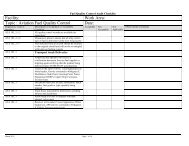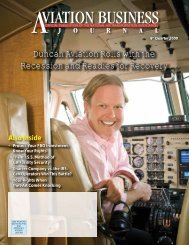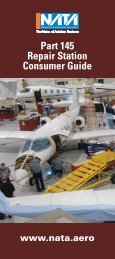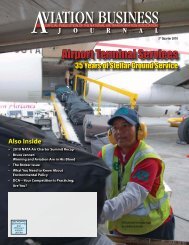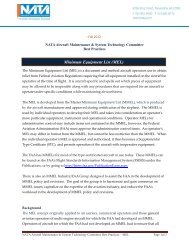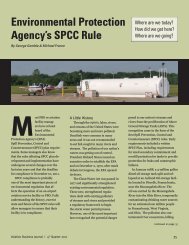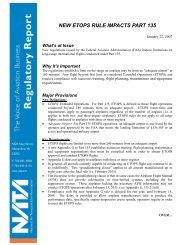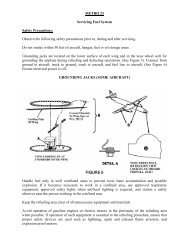Computer-Based Maintenance Tracking Flight Training ... - NATA
Computer-Based Maintenance Tracking Flight Training ... - NATA
Computer-Based Maintenance Tracking Flight Training ... - NATA
- No tags were found...
You also want an ePaper? Increase the reach of your titles
YUMPU automatically turns print PDFs into web optimized ePapers that Google loves.
INSIDE WASHINGTONOur VisionBy Lindsey McFarrenOn-demand air charter is one of the safestmodes of transportation. This is notmy opinion—it’s fact, based on statisticsavailable from the National TransportationSafety Board (NTSB). In fact, theindustry just achieved its lowest total accidentand fatality rate in ten years (see “The Viewfrom FL 300” for charter stats). So as the industrycelebrates its stellar safety record for 2006, what isthe point of a new foundation dedicated only to thesafety and security of charter operations?The Air Charter Safety Foundation (ACSF) visionis to promote safety and security of air charter inthe U.S. and worldwide. Certainly a worthy, noblecause, but exactly howdoes ACSF and its governingbodies—the ExecutiveCommittee and theBoard of Governors—intend to achieve thisvision?The Board of Governorsmet recently anddetermined the first goalsfor the ACSF. Two are intricate,ambitious goals, requiring nothing short of culturalchange within the entire charter industry. Othersare shorter-term projects, likely to have a more immediateeffect on individual operators who chooseto take advantage of them.The first complex goal is a single audit standard,acceptable and satisfactory to all factions of the industry.Any charter operator can list the multitudeof audits currently “required” to provide services toa specific fractional provider, broker, or even corporatecustomer—assuming they have enough fingersand toes to count that high. These audits cost operatorstens of thousands of dollars each year and varyin levels of value.The goal here is not only to create a uniform standard,but to raise the bar for many operators whoundergo an audit haphazardly or merely to put the“right” logo on their website. The ACSF has begundrafting such a standard and is incorporating thebest practices and standard operating procedures ofthe industry’s safest, most highly respected operators.A group of almost 20 operators, charter brokers,auditors, insurance companies, and chartercustomers is drafting the audit standard with ACSFguidance. The group has begun writing the auditormanual and will soon train auditors nationwide onthe new audit standard. Operators who successfullymeet the ACSF standard will be featured in anonline registry that is available free to the public,including charter brokers and charter clients.I have no misconceptions that this audit standardwill be immediately accepted industry-wide withopen arms. As with any major cultural change, thisnew audit standard will gain acceptance one operator,one customer, and one aircraft owner at a time.I know the hard work is not over whenthe standard is completed. Theefforts will have onlyjust begun. Once themanuals are drafted andauditors trained, the ACSFwill then commit to overseeingthe audit standard to ensurethat integrity and quality aremaintained from one auditor andoperator to the next.The ACSF’s second major task is to collect independent,objective data. The ACSF will undertaketwo data-collection projects. The first will collectsafety event data. That is, an event that does notrequire reporting to the NTSB or the Federal AviationAdministration (FAA), but that could have ledto such an accident or incident. This data will bede-identified by a third party and analyzed by ACSFstaff. The data will also be available online to ACSFmembers. This project will provide the ACSF andits members with potentially lifesaving trends of“oops” moments that could have ended in disaster.The ACSF will also collect general activity data.The FAA has been collecting data through an annualactivity survey, and although response has increasedeach year, the survey is still not completelyindicative of industry activity. Obviously, we as anindustry know how many accidents and incidentsare reported in a given year. But it’s this simple: Ifwe are not quite sure how much the industry flies,Continued on page 12Aviation Business Journal | 3 rd Quarter 200711


